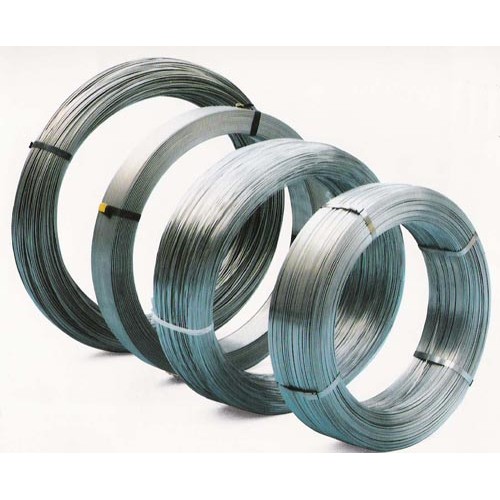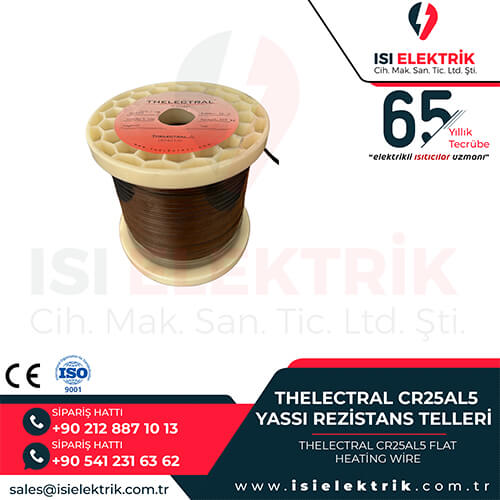Heating Wires
Heater wires are high-resistance wires used to convert electrical energy into heat energy, commonly utilized in the manufacturing of all types of heating elements. These wires have the fundamental characteristic of heating up when electric current passes through them due to their high resistance and temperature tolerance. This makes them ideal heating elements for a wide range of applications, from industrial machines to household appliances.
Heater wires are generally made from alloys of metals such as nickel, chromium, iron, and aluminum, providing them with the durability to withstand high temperatures. These materials allow the wires to function at elevated temperatures for extended periods of time. The wires ensure uniform heat distribution, making them highly efficient for heating purposes in various applications. Whether in industrial heating systems, furnaces, or everyday appliances, these wires are a reliable solution for converting electricity into heat with minimal energy loss.
The principle behind these wires is simple: electrical current flows through the wire, creating resistance, which in turn produces heat. The design of these wires, along with the materials used, ensures high performance with minimal energy waste. As a result, heater wires provide both efficiency and longevity, making them a preferred choice for both industrial and domestic heating applications.
We have CrAl series and CrNi series from 0.10 mm to 7 mm in stock.Our company is engaged in the import and export of resistance wires, the own brand THELECTRAL.We offer plastic coils from 0.10 mm to 1.30 mm, and coils with diameters above 1.30 mm.Resistance Wire
Resistance wire is the special name given to the resistance wires that convert the energy they receive from electricity into heat energy. Resistance wires are produced in different ways to be used in different areas. It consists of different amounts of metal or some alloys depending on the area of use. The most important reason for using these wires is their resistance to electric current.Resistance wires are produced in flat and round models. These products are produced from iron, aluminum, chrome and nickel materials. The operating temperatures also differ depending on the alloy condition. Round design resistance wire models are used for heating in industrial areas and industrial furnaces that require high temperatures. In the flat model, the resistance wires are suitable for cutting and gluing machines, hair sheath and micaceous machines.
Kanthal A1 Resistance Wire
The most common product among the wires in the resistances is the Kanthal A1 resistance wire. Kanthal is a resistance wire brand originating from Sweden. The most important feature is that it has a high degree of durability and can work at high temperatures.
Kanthal A1 resistance wire is produced in different diameters between 1 mm and 8.5 mm. These products can operate at temperatures as high as 1400 degrees. Thanks to these features, they can work in environments that require high temperatures.
Kanthal A1 resistance wires cause the lowest oxidation at high temperatures. They can work without any problems even under very difficult conditions. These products can work in all RBA, RDA, RTA, RDTA and rewindable POD systems.
Resistance Wire Properties
Resistance wires show a high resistivity as soon as electrical energy comes into the circuit they are in. This results in a high operating temperature. There are resistance wire types such as mica insulated, tube sheathed, cartridge, quartz and ceramic stone. At the same time, these products are produced from alloys such as chromium, aluminum and iron.
Resistance wires vary according to the usage material, especially the usage area. Due to these properties, the alloy ratio in the resistance wires varies. Thanks to their high strength in the area where they are used, they can take part in obtaining high temperatures.
Resistance Wire Usage Areas
Resistance wire usage areas are very wide. These wires usually perform processes such as heating, cooking and cleaning together with the temperature they obtain. Thanks to these features, they can be used in white goods and small household appliances. These wires fulfill the task of revealing the temperature in the resistors.
When choosing among resistance wire models, you should first choose according to the purpose of use. Because the properties of the wire will be different according to the model you choose. Resistance wires, which are resistant to high temperatures, are produced from quality materials. Among the most durable resistance wires are chrome nickel models. These products are used in devices operating under harsh conditions and high temperatures in industrial facilities.
Resistance Wire Prices
Resistance wire prices primarily vary according to product features. When choosing, you should choose a product specific to your project and usage needs. That's why you need to do research and comparisons on price. For standard productions, price information can be obtained instantly, while for special productions for your project, price information can be specified after the study.
Our company imports resistance wires produced from high quality materials and working under the toughest conditions at affordable prices. You can buy these products from our company at the most affordable prices. Our company provides you with a free discovery service about resistance wire. You can also get price information in line with your needs and order resistance wire immediately and ask us to offer you qualified solutions.
Heating Wires
Heating wires are a type of wire commonly used to provide electrical resistance. These wires are typically made of metal and are designed based on length, thickness, and material properties to produce a specific resistance value. In electricity, heating wires provide a specific resistance by impeding the passage of electric current. Heating elements in electrical circuits are used to control, protect, or limit the current flow. Heating wires are also used in industrial heaters, which are often wound onto a coil. When wound onto a coil, these wires generate heat as electric current passes through them, transferring this heat to the surroundings. Heating wires are commonly used in various industrial applications, electronic circuits, and heating systems. In heating systems, specifically, they are utilized to ensure that the wire heats up when electricity passes through it and transfers this heat to the surroundings. This is an example of usage that can be seen in heating elements, water heaters, or industrial furnaces.Heaters Wire Working Principle
- Heaters Wire Working Principle: Heater wires are used to limit or control the current in electrical circuits. When an electric current passes through a heater wire, due to the resistance of the wire, some of the current is converted into energy and the wire heats up. Therefore, heater wires are often used for heating purposes. For example, the coil inside an electric heater consists of a heater wire, and when an electric current is applied to the coil, the wire heats up and heats the surrounding air.
- Heaters Wire for Safety: Heater wires can also be used for safety purposes in electrical circuits. For example, in case of an overcurrent situation, the resistance of the heater wire can limit the current, preventing damage to the circuit or overheating.
Heaters Wire Technical Specifications
- Material: Alloys such as nickel-chromium (NiCr), nickel-iron (NiFe), chromium-aluminum (CrAl), and iron-chromium-aluminum (FeCrAl) are commonly used.
- Operating Temperature: Varies depending on the alloy used. Nickel-chromium alloys can be used up to 1200°C, chromium-aluminum alloys up to 1300°C, and iron-chromium-aluminum alloys up to 1400°C.
- Resistance: Resistance per unit length of the wire. Measured in Ohms (Ω).
- Specific Resistance: An indicator of the wire material's resistance to electrical current. Measured in Ohm-meters (Ωm).
- Thermal Expansion Coefficient: An indicator of the change in length of the wire due to temperature change. Measured in °C^-1.
- Melting Point: The temperature at which the wire melts. Measured in °C.
- Density: Mass per unit volume of the wire. Measured in g/cm³.
- Diameter: Thickness of the wire. Measured in millimeters (mm).
Some Common Types of Heaters Wire and Their Technical Specifications
Nickel-Chromium (NiCr) Heaters Wire:
- Material: 80% Nickel, 20% Chromium
- Operating Temperature: Up to 1200°C
- Resistance: 1.05 Ωm
- Specific Resistance: 1.05 Ωm
- Thermal Expansion Coefficient: 13.0 x 10^-6 °C^-1
- Melting Point: 1455°C
- Density: 8.4 g/cm³
Chromium-Aluminum (CrAl) Heaters Wire:
- Material: 23% Chromium, 5% Aluminum, 72% Iron
- Operating Temperature: Up to 1300°C
- Resistance: 1.25 Ωm
- Specific Resistance: 1.25 Ωm
- Thermal Expansion Coefficient: 12.5 x 10^-6 °C^-1
- Melting Point: 1538°C
- Density: 7.2 g/cm³
Iron-Chromium-Aluminum (FeCrAl) Heaters Wire:
- Material: 55% Iron, 25% Chromium, 20% Aluminum
- Operating Temperature: Up to 1400°C
- Resistance: 1.45 Ωm
- Specific Resistance: 1.45 Ωm
- Thermal Expansion Coefficient: 11.0 x 10^-6 °C^-1
- Melting Point: 1540°C
- Density: 7.5 g/cm³
Materials Used in Heaters Wire Production
- Nickel-Chromium Alloys: Nickel-chromium alloys are commonly used materials. These alloys offer advantages such as high temperature resistance and corrosion resistance.
- Iron-Chromium-Aluminum Alloys: These alloys are preferred especially for high-temperature applications. Variability in their resistance can be controlled depending on the use of different alloys.
- Nickel-Ferrite Alloys: These alloys have high electrical resistance and exhibit stable performance under temperature conditions. They are ideal for high-temperature applications.
- Kanthal Alloys: Kanthal is a commercial brand of Fe-Cr-Al (Iron-Chromium-Aluminum) alloys. It provides excellent durability and stable resistance at high temperatures.
Usage of Heaters Wires in Electrical Circuits
- Current Limitation and Control: Heaters wires can be used to limit or control the current in a circuit.
- Voltage Divider: They can be used as voltage dividers in circuits.
- Resistance Applications: They are used as a fundamental component in resistance circuits.
- Heating Applications: Heaters wires are also used to convert electrical energy into heat.
- Thermistors and Sensors: Some heaters wires can also be used as sensors in temperature sensing and control applications.
Industrial Applications of Heaters Wires
- Heating Elements: Industrial furnaces, ovens, dryers, cooking machines, and other heating systems widely use heaters. In these systems, heaters used as heating elements generate heat efficiently, optimizing energy consumption while ensuring heat is distributed quickly and evenly. Especially in metalworking, glass production, and ceramic furnaces, heaters provide the necessary heat for processing materials at high temperatures, enabling efficient and controlled processes.
- Plastic Extrusion and Molding: Plastic extrusion and molding machines rely heavily on heaters for heating and shaping plastic raw materials. In plastic production, controlled heat is required to melt the materials at high temperatures and shape them, and this is achieved by heaters. In extrusion lines, heaters are used to heat plastics and adjust their viscosity, improving energy efficiency and increasing production speed.
- Chemical Reactors and Processes: In the chemical industry, heaters are used for heating chemical reactors and process tanks. Maintaining a stable temperature is critical for accelerating or regulating chemical reactions, so heaters are employed to provide uniform heat distribution and energy efficiency. Additionally, heaters provide the high temperatures needed for chemical substances to remain stable while reacting, contributing to safe and efficient production processes.
- Packaging Industry: In the packaging industry, heaters are used in temperature-controlled packaging machines and heat sealing machines. The sealing and molding of plastic packaging, food products, and other materials require specific temperature control, which is made possible by heaters. In particular, in thermoforming packaging machines, heaters maintain the necessary temperature to shape and seal materials, offering high-performance solutions.
- Food Industry: In the food industry, heaters are used in ovens, cooking machines, heating tanks, and other heating equipment for food processing and cooking. In food production processes, it is essential to ensure that products are cooked, sterilized, or cooled at the right temperature. Heaters provide quick and efficient heating, ensuring food safety and energy savings. Additionally, in the food sector, hygiene and quality control are vital, making heaters easy to clean and long-lasting.
- Automotive Industry: In the automotive industry, heaters are used in vehicle heating systems, seat heaters, car heaters, and other heating applications. These heaters allow the vehicle's interior to heat up quickly, providing a comfortable driving experience for the driver and passengers. In addition, with the rise of new technologies such as electric vehicles, automotive heating systems have become more efficient. Heaters are used in vehicle heating systems to ensure high performance with low energy consumption. Furthermore, heaters are also used in vehicle defroster systems for windows to prevent frost and fogging.
Heaters and Features Providing High Heat Efficiency
Heaters are one of the preferred heating elements in both industrial and individual applications due to their high heat efficiency. The main advantage of these heaters is their ability to rapidly and efficiently convert electrical energy into heat. Features such as high temperature resistance and thermal conductivity allow these heaters to minimize energy loss while ensuring maximum heat transfer. The use of heaters contributes to reducing energy consumption and supporting environmental sustainability. Additionally, the even heat distribution provided by these heaters supports the long lifespan and efficient operation of the devices in which they are used.
- High Temperature Resistance: Heaters typically operate without issue at temperatures of 1000°C and above, making them suitable for high-performance applications.
- Even Heat Distribution: Heaters ensure that heat is distributed evenly across the surface, enhancing the performance of the devices.
- Long Lifespan: Heaters made from corrosion- and oxidation-resistant materials offer the possibility of long-term use.
- Low Energy Loss: Heaters experience minimal energy loss when converting electrical energy into heat, ensuring high efficiency.
Heaters and Technical Details
Heaters play a critical role in converting electrical energy into heat. The performance of these heaters depends on the properties of the materials used, design parameters, and application requirements. Heaters, commonly used in both industrial and household applications, are known for their high-temperature resistance, corrosion resistance, and long-lasting performance. The alloys and physical properties of the wires used in production processes ensure that these elements are suitable for various operating conditions. The selection of heaters should be made according to the specific needs of the application. Incorrect material or design selection can decrease energy efficiency and shorten the device's lifespan.
- Materials Used: Heaters are typically made from nickel-chromium (NiCr) and iron-chromium-aluminum (FeCrAl) alloys. These materials are resistant to oxidation and corrosion even at high temperatures. Nickel-chromium alloys provide flexibility and high electrical resistance, while iron-chromium-aluminum alloys offer low density and cost advantages.
- Electrical Resistance: The electrical resistance of heaters is an important parameter in heating applications. Resistance depends on the type of material, the length, and the diameter of the wire. Higher resistance generates more heat, but this can also affect energy consumption. Therefore, the appropriate resistance value should be selected for the application.
- Operating Temperature Range: Heaters typically operate at temperatures ranging from 100°C to 1200°C. Heaters designed for high-temperature applications can form a protective oxide layer against oxidation, contributing to their long lifespan.
- Corrosion Resistance: Heaters used in chemical and humid environments must be resistant to corrosion. Nickel-chromium alloys are preferred for systems working in seawater or acidic environments.
- Thermal Expansion: Heaters expand when heated. Therefore, the thermal expansion rate should be considered in the systems where the heater is used. High expansion rates require careful design of mechanical fastenings.
- Long-lasting Performance: The lifespan of heaters depends on the operating conditions and the materials used. Heaters made from high-quality alloys provide long-term, stable performance. Durability is especially crucial in industrial applications that require continuous use.
- Wire Thickness and Length: The thickness and length of the wire determine the resistance value and, consequently, the amount of heat produced. Thicker wires offer lower resistance, while thinner wires provide higher resistance. These parameters should be optimized according to the energy and heat requirements of the application.
Frequently Asked Questions
Heating Wires


-500x500.jpg)
